2014 Yamaha FZR Review
Agile two-seater receives potent performance upgrade
“RXP-X killer.”
That’s how I first heard the 2014 Yamaha FZR described. After riding the craft recently in Georgia, I understand the description. Once a performance-oriented two-seater with a novel extending handlebar, the FZR has now morphed into a truly bad-ass, race-ready bully.
A cold-hearted Sea-Doo killer? Perhaps not completely. But a more-than-worthy adversary for the aforementioned RXP-X… absolutely.
More Powerful Engine, Improved Pump
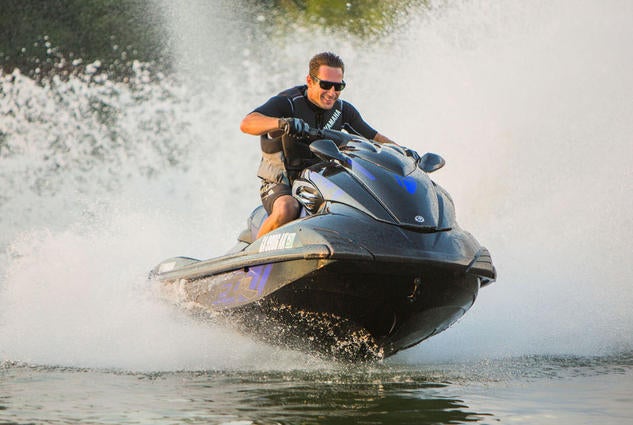 The Yamaha FZR benefits from much improved power for 2014.
The Yamaha FZR benefits from much improved power for 2014.With the success of the RXP-X, Yamaha obviously thought it was high time to pay attention to their own performance two-seater. First on the agenda was to ditch the previous Super High Output engine. It was probably time. The SHO produced about 211 horsepower, not too shabby but certainly far from the mark of competitor’s best offerings. Its replacement – the Super Vortex High Output – suffers from no such shortcomings. The same engine that also made its debut in an FX model for ’14, the SVHO is the next step in the evolution of Yamaha’s 1.8-liter powerplant. It received a list of improvements. Both the supercharger and intercooler have been tweaked. The former uses a new larger design and six vanes to produce a reported 60% more boost. The latter also gets an increase in size, along with an advertised 22% increase in efficiency. Other upgrades? Cast pistons were swapped out for stronger, compression-forged replacements, a new oil cooler is 110% more efficient and injectors have been increased in size from 42 to 60 pounds.
COMPARISON: 2013 Yamaha FZR Review
Transferring that power to the water has also been addressed. Previously, the FZR used a 155mm pump and simple, straight-bar intake grate. Suffice it to say, they’ve been thrown in the scrap heap. The 2014 version opts for a larger 160mm pump with eight vanes, and opens up the exit diameter to 85mm. Loading that pump is now the job of a long-overdue top-loading scoop grate. It’s reinforced with a second set of mounting bolts to handle the pressure. Aft, the adjoining ride plate has been extended similar to many aftermarket plates.
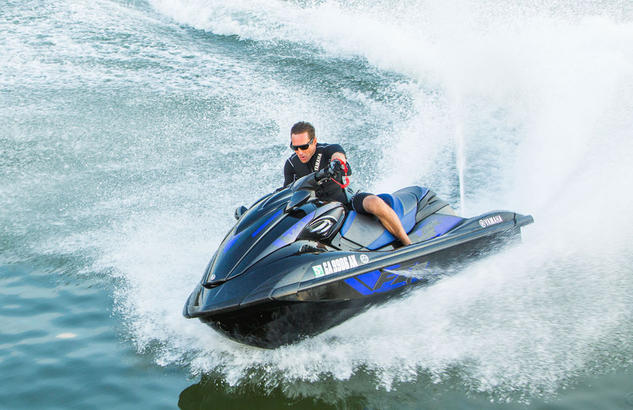
As to the hull, it stays mostly the same, save for a key sponson change. The new sponsons are longer in length and positioned farther aft. That change is apparent the minute you throw the boat into a corner…
Hold On To Your Hat
And throw a boat like this into a corner you must. But first, I couldn’t resist simply squeezing its throttle and seeing what all that engine tinkering could produce.
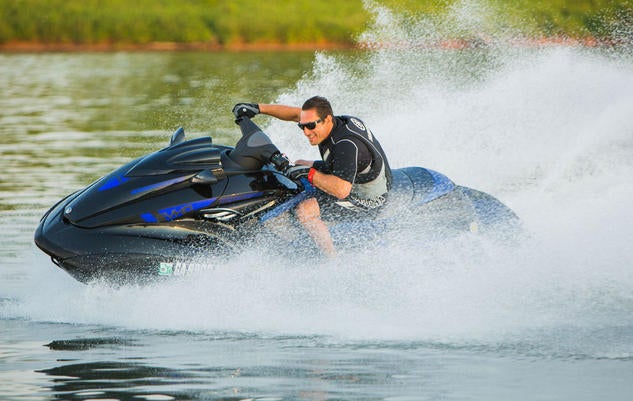 When you squeeze the throttle on the 2014 FZR, you’d better be holding on tight.
When you squeeze the throttle on the 2014 FZR, you’d better be holding on tight.
Word to the wise? Hold on tight. Squeeze the throttle of the FZR and you’ll reach the 30 mph mark arguably faster than any other production personal watercraft. Without a dedicated acceleration-testing setup, I judged 0-30mph times to be easily as quick as 1.5 seconds using good old-fashioned GPS and a stopwatch. I’ve heard reliable reports that, under the right conditions, 0-30 acceleration may actually be as fast as 1.3 seconds.
COMPARISON: 2014 Sea-Doo RXP-X 260 Review
That’s arm-stretching, exploding-out-of-the-hole quick. Just make sure you’re holding on, have the bow trimmed down, and are keeping your weight over the nose…lest you be left behind.
Top speed? That can vary depending on rider weight, skill, and conditions, but with my relatively light 155-pound load and calm waters, I watched 70 mph show up on my GPS with no problem. Yamaha reps hinted that the speed may come down ever so slightly for production to keep certain parties happy, but I predict the FZR will have no trouble reaching the now-magic 67 mph. (That’s the Coast Guard-agreed 65 mph, with a two-mile-an-hour leeway.) Throw a lightweight rider on it in good conditions and chances are good you’ll see more.
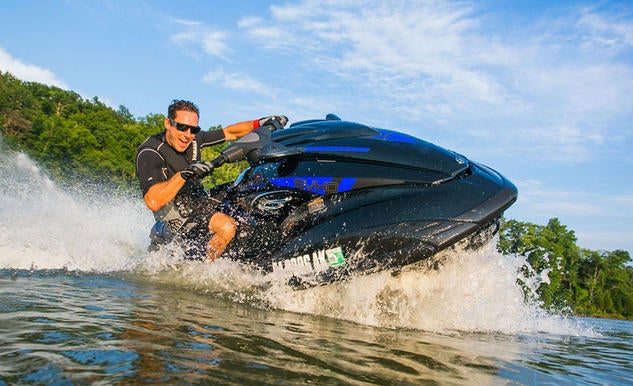 Thanks to bigger sponsons and their placement, cornering is much improved.
Thanks to bigger sponsons and their placement, cornering is much improved.Now, back to that handling. The FZR has always been a hard-cornering machine, using rounded chines to roll easily into a corner with an intuitive inside lean. The change in sponson size and placement, however, has taken that cornering to a whole new level. To put it bluntly, the FZR cornered as hard as I could push it, and could have gone further had I had the upper-body strength to stay aboard. That may be the one area where the FZR and RXP-X differ. With the seat shape of the RXP-X, I find it slightly easier to push the craft to the absolute edge thanks to the ability to transfer a lot of the force to my legs. I feel like I can probably turn the FZR every bit as hard…but I may need to hit the gym first.
Aftermarket Mods…In Stock Trim
Almost lost in the excitement is the FZR’s first innovation, its telescoping steering column. It lets riders extend the handlebars upward for a more comfortable stance when riding out of the saddle. Those bars can also extend downward below the norm, giving the rider a low-to-the-water, aggressive feel. Yet another previous innovation is Yamaha’s NanoXcel hull material. It lightens the craft’s weight without sacrificing strength.
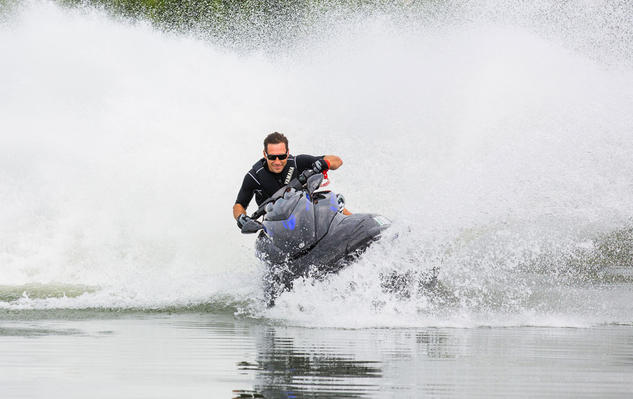 Performance is similar to a 2013 FZR outfitted with a litany of aftermarket parts.
Performance is similar to a 2013 FZR outfitted with a litany of aftermarket parts.The previously mentioned trim is a must. Use it to lower the bow not only for driving out of the hole, but also to lower the bow and put more hull in the water when cornering. Raise it to trim the bow and deliver the best top speed. Elsewhere, count on a keyfob-style remote to lock the ignition against unauthorized use or to trigger a low rpm mode to prevent users from achieving the craft’s full speed potential. And, yes, you still get the reverse on the starboard side, which prevents the easy use of throttle.
COMPARISON: 2013 Kawasaki Jet Ski Ultra 300X Review
All in all, however, the FZR changes the game for Yamaha. It’s like the aftermarket-tweaked performance version of its former self, but at a lower cost than you’d shell out for those same aftermarket mods. It also runs on 87 octane gas and comes with a factory warranty.
In short, it’s one killer machine.
| 2014 Yamaha FZR Specs | |
| Length | 132.7 inches |
| Beam | 48.4 inches |
| Curb Weight | 827 lbs |
| Engine | Four-cylinder, four-stroke, supercharged/intercooled |
| Displacement | 1,812 cc |
| Bore and Stroke | 86mm x 78mm |
| Compression Ratio | 8.6:1 |
| Rated Horsepower | N/A |
| Fuel Capacity | 18.5 gal. |
| Combined Stowage Capacity | 21.3 gal. |
| Colors | Black Metallic |
| Price | $14,499 |
Get PersonalWatercraft.com in your Inbox!
Like PersonalWatercraft.com on Facebook
Comments
Most Popular

2025 Yamaha JetBlaster PRO 2-Up Review

Remembering the Sea-Doo XP

2024 Kawasaki Jet Ski STX 160X Review

2017 Kawasaki Jet Ski Ultra 310LX Review

2024 Yamaha GP HO Review













 Your Privacy Choices
Your Privacy Choices